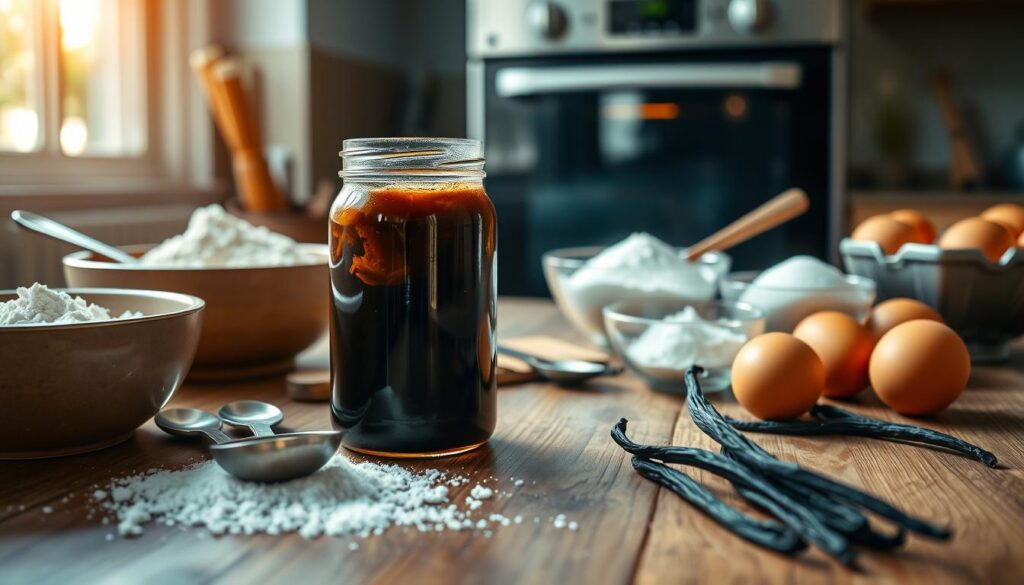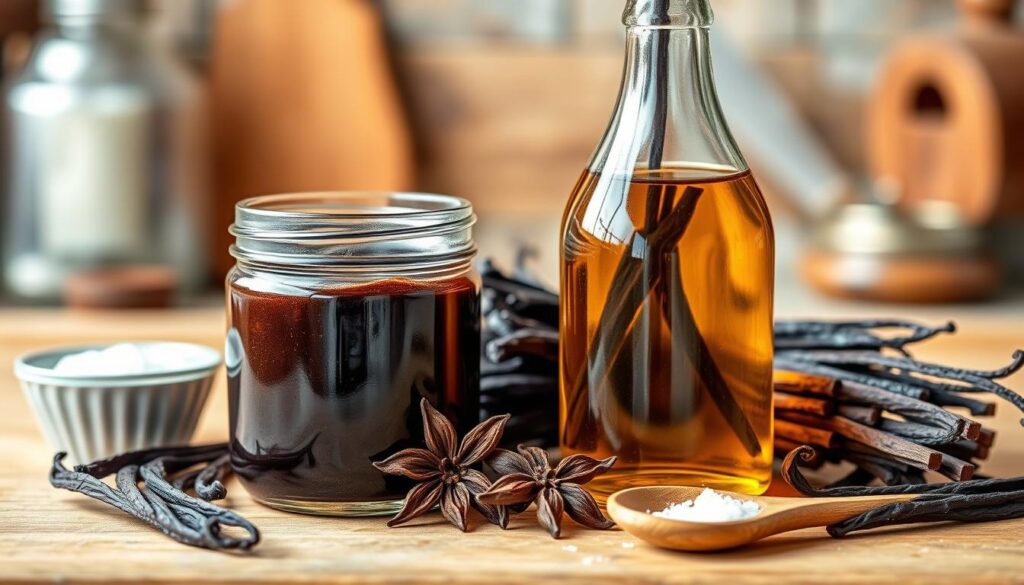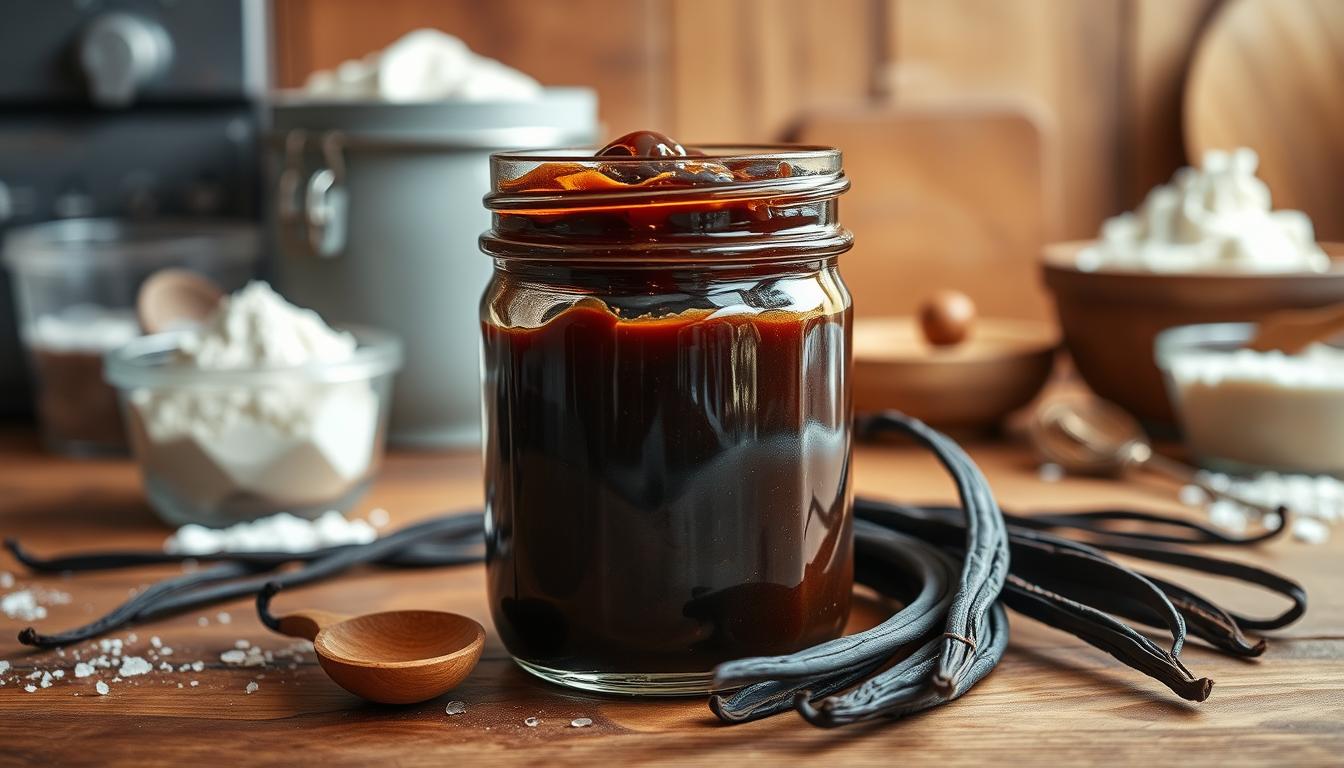I love baking and the smell of vanilla is amazing. It makes my desserts taste so much better. But buying vanilla paste can be expensive. That’s why I’m excited to teach you how to make it at home.
Making your own vanilla paste saves money and lets you control the quality. You can make a batch in just a few minutes. It will last for months and make your baking even better. Get ready to make your own homemade vanilla paste and enjoy the delicious taste. Trying to figure out Vanilla Paste Recipe? Let’s work on it!
Table of Contents
Key Takeaways
- Homemade vanilla paste is a cost-effective alternative to store-bought versions.
- The recipe requires minimal ingredients and can be customized to your taste preferences.
- Vanilla paste provides a more intense and complex vanilla flavor compared to vanilla extract.
- Homemade vanilla paste can be used in a variety of baking and cooking applications.
- Crafting your own vanilla paste allows you to control the quality and avoid any unwanted additives.
What is Vanilla Paste and Why You Should Make It
Vanilla paste is a must-have for every home cook. It’s made by grinding vanilla bean pods into a thick paste. This paste has real vanilla bean flecks, giving a stronger and more aromatic flavor than vanilla extract.
Definition and Ingredients
Vanilla paste is a twist on vanilla extract. It’s a spreadable paste with a sweet vanilla flavor. Unlike store-bought options, homemade paste lets you choose the ingredients for a natural taste.
Benefits of Homemade Vanilla Paste
- Intense, concentrated vanilla flavor that elevates baked goods and desserts
- Visually appealing vanilla bean specks that add a gourmet touch to your creations
- Ability to customize the recipe to your taste preferences, such as using different types of sugar
- Cost-effective alternative to purchasing pre-made vanilla paste or vanilla beans
- Versatile for use in both sweet and savory dishes, from cookies and cakes to sauces and marinades
Making your own vanilla paste at home offers many benefits. It lets you enjoy a high-quality, natural ingredient. With just a few steps, you can add a burst of pure vanilla flavor to your dishes.
Essential Ingredients for Your Vanilla Paste Recipe
To make a delicious vanilla paste at home, you need just a few ingredients. The key is to use high-quality vanilla beans. Look for Grade A beans for their moisture and flavor.
These beans should be plump and oily. They are full of the good stuff that makes vanilla taste so great.
You’ll also need to pick the right sugar. Granulated white sugar is a classic pick. But you can try agave nectar or honey for a different taste. Adding a bit of corn syrup or glycerin helps prevent crystals from forming.
Vanilla Beans: How to Choose the Best
For your vanilla paste, choose beans that are plump and moist. Vanilla beans from Madagascar or Tahiti are top-notch. They have a deep, rich flavor.
These premium beans might cost more. But their quality is worth it.
Sugar: Types You Can Use
Granulated white sugar is the most common choice. But you can also use agave nectar or honey. They add flavor and act as natural preservatives.
Choose the amount of sugar based on how sweet you like it.
Additional Flavor Enhancers
Adding a bit of high-quality alcohol like vodka or rum can improve the flavor. It also helps prevent crystals. A small amount of corn syrup or glycerin can make it creamier.
With the right mix of vanilla beans, sweeteners, and flavor boosters, you’ll make a fantastic vanilla paste. It will take your baking and cooking to the next level.
Easy Steps to Make Vanilla Paste
Do you love the rich, aromatic flavor of vanilla? Making your own vanilla paste at home is a delight. It’s cheaper than buying it and lets you adjust the flavor. Here’s how to make your own batch of this versatile ingredient.
Step-by-Step Instructions
- Gather your ingredients: vanilla beans, sugar, alcohol (such as rum or vodka), corn syrup, and water.
- Cut the vanilla beans into 2-3 inch pieces and add them to a high-speed blender.
- In a separate bowl, combine the sugar, alcohol, corn syrup, and water. Stir until the sugar has dissolved.
- Pour the sugar mixture into the blender with the vanilla beans.
- Blend the ingredients on high speed for 2-3 minutes, until the mixture is smooth and creamy.
- Transfer the vanilla paste to airtight storage containers and let it sit overnight to thicken.
Tips for Proper Mixing
- For best results, use a blender with a smaller cup or jar. If your blender has a larger pitcher, consider doubling the recipe.
- Make sure the vanilla beans are finely ground for a smooth, consistent texture in the paste.
- Adjusting the ratio of sugar, alcohol, and corn syrup can help you achieve your desired flavor profile and consistency.
With these easy steps, you’ll have homemade vanilla paste that can elevate your baking and cooking to new heights. Enjoy the rich, aromatic flavor of your own vanilla paste recipe in all your favorite desserts and savory dishes.
Common Mistakes to Avoid When Making Vanilla Paste
Making the perfect vanilla paste recipe at home needs careful attention. The process might seem simple, but there are common mistakes to avoid. These mistakes can ruin the taste of your homemade vanilla paste. By knowing what to avoid, you can make a paste that will make your baking and cooking better.
Over-Processing the Ingredients
Blending the ingredients right is key when making vanilla paste. But, blending too long can make it taste bitter. Don’t blend for too long. You want it smooth but not too fine.
Using Old or Dried Vanilla Beans
The quality of your vanilla beans matters a lot. Don’t use old, dry beans. They won’t give you the same flavor. Use fresh, moist beans for the best taste. If you have dried beans, soak them first to make them work well in the paste.
By avoiding these mistakes, you’ll make a vanilla paste recipe that looks great and tastes amazing. With a bit of practice, you can make excellent homemade vanilla paste in your kitchen.
How to Store Your Homemade Vanilla Paste
Keeping your homemade vanilla paste fresh is key. A few easy steps can help your paste stay creamy and flavorful. This way, it’s always ready to make your baked goods, desserts, and savory dishes even better.
Ideal Conditions for Storage
Keep your homemade vanilla paste in a cool, dry spot. Stay away from sunlight. Glass jars with tight lids are best to block air and moisture. Don’t use plastic containers, as they can add bad flavors.
Shelf Life of Vanilla Paste
Your vanilla paste can last a year if stored right. Stir it before each use and clean the jar lid with a damp paper towel. This prevents sticking. For the best taste, let it sit for 2 weeks to a few months before using it.
Follow these storage tips to enjoy your homemade vanilla paste for months. Your creations will shine with the perfect vanilla touch.
Using Vanilla Paste in Your Favorite Recipes
Vanilla paste can make your baking and cooking better. It’s great for making tasty cookies, cakes, and ice cream. It adds a special flavor to your dishes.
Baking: Cookies, Cakes, and More
Vanilla paste is perfect for baking. Use it like vanilla extract to make your treats taste amazing. Try it in Dark Chocolate Truffles, Russian Tea Cakes, and Jam Cakes for a unique twist.
Cooking: Savory Dishes Enhanced
Vanilla paste is not just for sweets. It’s also great in savory dishes. Mix it into sauces and dressings for a richer taste. Try it in Salmon with Curried Rum and Vanilla Sauce or Spring Vegetables with Tahitian Vanilla Paste Vinaigrette for a new flavor.
Homemade Ice Cream: A Sweet Treat
Vanilla paste changes ice cream making. Add it to your custard base for Vanilla Coconut Cream Ice Cream. Or, use it to make Vanilla Cupcakes with Mascarpone Vanilla Cream Frosting even better. It’s a versatile ingredient.
Vanilla paste is essential for anyone who loves to cook or bake. It brings out the best in your recipes. Try it and see how it can make your dishes even more delicious.

Substitutions and Alternatives to Vanilla Paste
Homemade vanilla paste adds a unique flavor to your recipes. But sometimes, you might need a substitute. This could be because of cost, availability, or dietary needs. Knowing your options can help you make tasty dishes even without the vanilla bean flecks.
Using Pure Vanilla Extract
Pure vanilla extract is a good substitute for vanilla paste. Start with a 1:1 ratio, but adjust as needed. Remember, vanilla extract doesn’t look the same as the paste, so your dish might look different.
When to Use Vanilla Powder Instead
Vanilla powder is another great choice. It’s perfect for recipes without extra liquid, like dry mixes. Use half a teaspoon of vanilla powder for every teaspoon of paste.
For a sugar-free vanilla paste, try vegetable glycerin. It has a similar texture and taste without the sugar.
Remember, vanilla paste has a stronger flavor than vanilla extract. So, use less of it to get the right taste in your dish.
“Vanilla paste and powder are noted to be more economical alternatives to whole vanilla beans.”
| Substitute | Ratio to Vanilla Paste | Notes |
|---|---|---|
| Vanilla Extract | 1:1 | Lacks visual appeal of vanilla bean flecks |
| Vanilla Powder | 1/2 tsp per 1 tsp paste | Ideal for dry mixes or coatings |
| Vegetable Glycerin | 1:1 | Sugar-free alternative to vanilla paste |
Frequently Asked Questions About Vanilla Paste
Homemade vanilla paste raises a few common questions. Let’s tackle a couple of the most asked ones. This will help you understand this versatile ingredient better.
Can I Use Different Types of Sugar?
Yes, you can! The traditional recipe uses granulated sugar, but you can try other sweeteners too. Here are some good alternatives:
- Agave nectar
- Honey
- Maple syrup
Each sweetener gives the vanilla paste a unique flavor. Honey adds a floral touch, while maple syrup brings a caramelized taste. Feel free to experiment and find the perfect sweetener for you.
What’s the Difference Between Vanilla Paste and Extract?
The main difference is in their texture and flavor. Vanilla paste is thicker and has visible vanilla bean specks. It has a stronger vanilla taste. Vanilla extract, on the other hand, is a liquid with a milder flavor.
When substituting, remember that one tablespoon of vanilla bean paste is like one vanilla bean. Also, one teaspoon of vanilla paste is the same as one teaspoon of vanilla extract in recipes.

“Vanilla is one of the most expensive spices to produce ounce for ounce.”
Whether you use vanilla paste or extract, both can enhance your dishes. Try both and see which one works best for you in your cooking and baking.
Enhancing Your Vanilla Paste Recipe
Mastering the basic vanilla paste recipe is just the start. You can then explore endless possibilities by adding new flavors or ingredients. This way, you can make unique and tasty vanilla-based treats.
Adding Other Flavors
Vanilla goes well with many spices and botanicals. Try using different vanilla bean types, like Tahitian or Ugandan, to find unique tastes. Adding warm spices like cinnamon, cardamom, or nutmeg can also give your homemade vanilla paste a cozy aroma.
Adding citrus zest, like lemon, orange, or lime, can add a bright, refreshing touch. It complements the rich vanilla flavor beautifully.
Infusing Your Paste with Additional Ingredients
To make your vanilla paste recipe even richer, use more vanilla beans than liquid. This makes the paste thicker and more flavorful.
Using spent vanilla beans from homemade extract is a smart move. It’s cheaper and can enhance your paste’s taste. Just remember, you might need some fresh beans too for the best flavor.
Experimenting with your vanilla paste is all about having fun. By trying different flavors and methods, you can create a special vanilla experience. This will take your baking and cooking to new levels.
Conclusion: Enjoying Your Homemade Vanilla Paste
Making your own vanilla paste at home is exciting. You can try different sugars, vanilla beans, and flavors to make it special. The secret to the best flavor is letting it sit for a while.
Encouragement to Experiment
Don’t be shy to try new things with your vanilla paste. Add a bit of bourbon, brandy, or cinnamon for a unique taste. Homemade vanilla paste is all about being creative.
Final Tips for the Perfect Paste
Keep these tips in mind as you make your vanilla paste: Use top-quality vanilla beans for the best taste. Store it right to keep it fresh. Most importantly, have fun and enjoy the amazing flavor of your homemade vanilla paste. It will make your baking, cooking, and ice cream even better.
FAQ
Can I use different types of sugar in the vanilla paste recipe?
Yes, you can try different sugars in your vanilla paste. Options include granulated sugar, agave nectar, honey, or maple syrup. Each will change the flavor and sweetness level.
What’s the difference between vanilla paste and vanilla extract?
Vanilla paste and extract differ in consistency and flavor. Paste is thicker and has visible specks of vanilla bean. It offers a stronger flavor than extract, which is a liquid.
Can I use vanilla powder instead of paste?
Yes, vanilla powder is a good substitute for paste, mainly in dry recipes. Remember, paste has a stronger flavor. So, you might need to use less when swapping.
How long does homemade vanilla paste last?
Homemade vanilla paste can last up to a year if stored right. Keep it in a cool, dry spot away from sunlight. Use a glass jar with a tight lid.
Can I infuse my vanilla paste with other flavors?
Absolutely, you can add flavors like cinnamon, cardamom, or citrus zest to your vanilla paste. This makes for tasty and unique variations in your baking and cooking.

